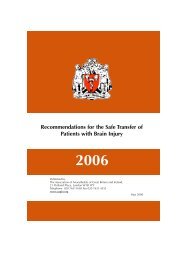TheatrePracticeStandardsGeneric1
You also want an ePaper? Increase the reach of your titles
YUMPU automatically turns print PDFs into web optimized ePapers that Google loves.
• Forensic specimens must be saved in accordance with local policy ensuring that there<br />
is a total traceability of the specimen at all times until it reaches its destination.<br />
• Some forensic samples will not necessarily be body tissue eg: a bullet or shot removed<br />
during surgery from firearm wounds.<br />
• When orthopaedic implants or other mechanical devices (eg: ventricular assist devices)<br />
are to be removed, the following must be ascertained:<br />
• Whether the implant is to be sent for bacterial, pathological, metallurgical or<br />
mechanical examination.<br />
• The legal ownership of the implant before any destructive testing is carried out.<br />
• Foetal Tissue<br />
• It is imperative that personal wishes are respected in relation to a foetus or foetal<br />
tissue, and the guidelines followed in the:<br />
o<br />
Policy on Procedure for the sensitive disposal of pre-24 week foetal tissue.<br />
• Laboratory staff need to be informed of any personal wishes expressed if a foetus or<br />
foetal tissue needs to be sent for pathological examination.<br />
• Foetal tissue must be treated in accordance with Health Service Guidelines HSG<br />
1991/19 (NHS Management Executive 1991).<br />
• Temporal Artery Biopsy<br />
• Temporal Artery Biopsy or Specimens of Similar Size<br />
• For Temporal Artery Biopsy or similar size specimens a ‘cellsafe’ biopsy capsule must<br />
be used to reduce the risk of the specimen migrating and become ‘missing’.<br />
• Traceability<br />
• There must be a central point for specimens and specimen forms to be taken to<br />
following an operation. A specimen folder will hold tracking forms that require filling in<br />
with information about the specimen including date, patient’s name, hospital number,<br />
date of birth, ward, operating theatre, specimen details, number of the specimen (if<br />
more than one), details on type of investigation e.g. histology, microbiology, clinical<br />
chemistry, confirmation that the specimen label and specimen form match in accuracy.<br />
• The staff member who completes the specimen tracking form is responsible for<br />
ensuring that the patient labels on both specimen and specimen form tally, that the<br />
surgeon has signed the specimen form and that formalin is added if appropriate.<br />
• Both the specimen and specimen form must then be placed in the cool box/collecting<br />
box provided. The box must be lined with a large plastic bag and forms must be put<br />
in a smaller plastic bag. The lid of the cool box lid must be replaced. If the specimen is<br />
too large for the box please it must be placed in a large bag with the form and put on<br />
the floor.<br />
• The cool box/collecting box will be collected from this central point on a regular basis<br />
during the day (or at certain agreed times for each department); the last collection in<br />
the afternoon will be while the lab is still open. Any specimens put in the cool<br />
box/collecting box after that time will stay at the central point until the first collection of<br />
the next day.<br />
• If the surgeon has asked for a histology specimen to go to the histology laboratory for<br />
frozen section, the tracking form must be completed and both the specimen and<br />
specimen form (in a bag) must be passed to a porter to take to the lab immediately.<br />
• It is the individual responsibility of each person who takes the specimens to the central<br />
place to ensure that all details are correct prior putting them in the box.<br />
65





